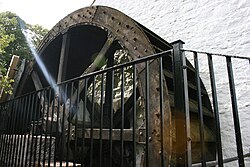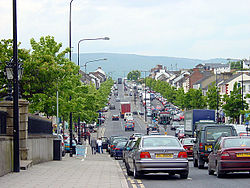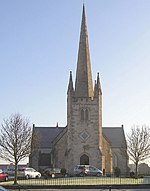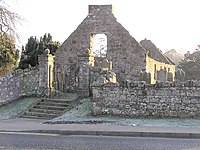Cookstown: Difference between revisions
m clean up, typos fixed: open air → open-air, ten year → ten-year, 1790's → 1790s |
m →Nineteenth century: clean up, replaced: Train station → railway station |
||
| Line 86: | Line 86: | ||
===Nineteenth century=== | ===Nineteenth century=== | ||
Cookstown's greatest development came with the Industrial Revolution. With the establishment of Gunning's Linen Weaving Mill, the expansion of the Wellbrook linen finishing estate, the establishment of Adair's weaving mill at Greenvale and the final arrival of the railways, Cookstown's population quadrupled between 1820 and 1840. The railways allowed the fast transport to and from the town of agricultural produce. Two railways established | Cookstown's greatest development came with the Industrial Revolution. With the establishment of Gunning's Linen Weaving Mill, the expansion of the Wellbrook linen finishing estate, the establishment of Adair's weaving mill at Greenvale and the final arrival of the railways, Cookstown's population quadrupled between 1820 and 1840. The railways allowed the fast transport to and from the town of agricultural produce. Two railways established termini at Cookstown - the London, Midland and Scottish Railway in their dressed stone station designed by Charles Lanyon (now much altered as a Chinese restaurant on Molesworth Street) and the Great Northern Railway in their brick station next door (now Cookstown High School's Hockey Club). Both transported goods and livestock for sale to Cookstown's market. | ||
With the exception of Killymoon Castle, all of Cookstown's best architecture dates from this period and the town still resembles almost exactly the town developed at this time. Probably foremost among the buildings of this period is J.J. McCarthy's Church of the Holy Trinity on Chapel Street which is one of McCarthy's earliest commissions in which the influence of AWN Pugin's St. Giles' in [[Cheadle]] can be ascertained. | With the exception of Killymoon Castle, all of Cookstown's best architecture dates from this period and the town still resembles almost exactly the town developed at this time. Probably foremost among the buildings of this period is J.J. McCarthy's Church of the Holy Trinity on Chapel Street which is one of McCarthy's earliest commissions in which the influence of AWN Pugin's St. Giles' in [[Cheadle]] can be ascertained. | ||
Latest revision as of 20:20, 29 January 2021
| Cookstown Scots: Cookestoun | |
| Tyrone | |
|---|---|
 Water wheel at the Wellbrook Beetling Mill | |
| Location | |
| Grid reference: | H8178 |
| Location: | 54°38’49"N, 6°44’42"W |
| Data | |
| Population: | 10,646 (2001) |
| Post town: | Cookstown |
| Postcode: | BT80 |
| Dialling code: | 028 |
| Local Government | |
| Council: | Mid-Ulster |
| Parliamentary constituency: |
Mid Ulster |
Cookstown is a town and townland in Tyrone; the fourth largest town in the county. At the 2001 census it had a population of nearly 11,000.
Cookstown was founded around 1620 when the townlands in the area were leased by an English ecclesiastical lawyer, Dr Alan Cooke, from the Archbishop of Armagh, who had been granted the lands after the Flight of the Earls. It was one of the main centres of the linen industry West of the River Bann, and until 1956, the processes of flax spinning, weaving, bleaching and beetling were carried out in the town.
Cookstown's famous main street (laid out from around 1735 to 1800) is 1¼ miles long and 135 feet wide; one of the longest, and widest in the British Isles.
Things about the town

- An open-air market is held each Saturday in the main street
- The Cookstown 100 National Road Race is an annual motor biking event attended by many motorbiking enthusiasts, usually held in April.
- Ardboe High Cross and Abbey, one of the best examples of a 9th/10th century High Cross in Ireland, is 10 miles from Cookstown. 22 panels illustrate stories from the Old Testament and the New Testament
- Tullyhogue Harbour: a busy port and ferry terminal on Lough Neagh
- Other ancient sites nearby include:
- Beaghmore stone circles
- Tullyhogue Fort (below)
Tullyhogue Fort
Tullyhogue Fort stands beside the village of Tullyhogue). It was the inauguration site of the chiefs of Tyrone (Tir Eogain), the O'Neills. Destroyed in 1602, the fort was salvaged to some degree in 1964, when the site was cleared and presented. Though none of the original buildings remain, the unusual layout (raised inner mounds, but no outer defensive ditch) is still clearly visible. Tullaghogue is now owned and maintained by the Northern Ireland Environment Agency
The Donaghrisk walled cemetery to the southwest of (and clearly visible from) the fort is the resting place of the O'Hagans, the chief justices of Tyrone (and as such, they presided over the inauguration ceremonies of the O'Neills).
Lissan House
- Lissan House lies on the outskirts of Cookstown. It is a huge structure of little architectural beauty but enormous historical significance and was, until the death of its last inhabitant, Hazel Radclyffe Dolling (daughter of the 13th Baronet of Lissan, Sir Robert George Alexander Staples), in 2006, the oldest domestic dwelling in Ireland continually inhabited by one family. The entrance front is dominated by a vast porte-cochere built in about 1830.
Inside, the most striking feature is the bizarre and gargantuan oak staircase which rises from the stone flagged entrance hall the full height of the building. This was constructed by a local carpenter from the remnants of a rare 17th-century staircase which collapsed (along with the floors between it) as a result of dry rot in the 1880s and is quite unique, having flights springing at every conceivable angle, some of which go nowhere.
The other most notable feature of the house is its octagonal ball room added by Sir Thomas Staples (Queen's Advocate in Ireland) in about 1830 with its fine restrained neo-classical plasterwork, Dublin chimneypiece and carved door frames. The house currently lies empty, its contents in storage, but a Trust was established on the death of Mrs Radclyffe Dolling to oversee the restoration of the house and its development into accommodation and conference facilities.
Killymoon Castle
Killymoon Castle is about a mile south east of Cookstown. This imposing structure is Cookstown's finest piece of architectural heritage. It was built in just over a year at a cost of £80,000 and was Nash's first Irish commission. It is two stories high and has two large towers to the East and West, one circular the other (slightly lower) octagonal. Parts of the original castle were retained and its former Chapel became Nash's library. Inside the dramatic entrance porte-cochere can be found a return staircase leading to the octagonal drawing room and oval dining room. The Stewarts sold the castle in 1852 and, after passing though the hands of some 6 owners, it was sold for the final time in 1922 to a local farmer for the princely sum of £100. The same family retains it to this day.
Drum Manor
About 5 miles from the town is Drum Manor. Alexander Richardson, a burgess from Edinburgh, Scotland, bought the estate of Craigbalk in 1617 and built Drum Manor, which was also known Manor Richardson.[1] Alexander's son Sir William Richardson left it to his second son, Alexander, from which the Richardson's of Drum descend.[1] Sir William's third son, William, who inherited lands near Augher, obtained a lease for lands in the townland of Tullyreavy on the Drum Manor estate, where he built a house by the lake known as Oaklands.[1] In 1868 Viscount Stuart (later the 5th Earl Castle Stewart) married Augusta Richardson-Brady, heiress to the Oaklands Estate. Immediately upon marriage, Lord Stuart set about reconstructing Oaklands into the Tudor revival Drum Manor. This battlemented sandstone structure once had a tall tower to the East near the entrance front which was dominated by a huge entrance portal surmounted by a large tracery window which contained Victorian armorial stained glass. Lord Stuart was also responsible for setting out the formal gardens and demesne which survive to this day. Lord Stuart's grandson sold the estate to the Forest Service in 1980 and the Service set out the woodland habitat that exists today. However, in an attempt to avoid incurring rates liability, the Forest Service decided to demolish the Manor. Today, Drum Manor Forest Park is one of Cookstown District's largest tourist attractions (complete with the highest-rated caravan site in the District) but the only the ground floor outer walls of the Manor House survive.
Churches

- Church of Ireland:
- St Luran's, Parish of Derryloran: on Church Street, thought to have been built in 1822 by John Nash, though later work would have subsumed Nash's original. Nash's plans show a castellated and battlemented church from which only the tower and spire bear any resemblance to the structure standing today. The interior is a typical Victorian church structure with a chancel arch, hammer beam roof and large sanctuary with sparse but dignified decoration.
- St John's
- Kildress Church
- Baptist: Cookstown Baptist Church
- Church of God: Church of God
- Free Presbyterian: Cookstown Free Presbyterian Church
- Methodist:
- Presbyterian:
- First Presbyterian Church
- Molesworth Presbyterian Church
- Roman Catholic: Holy Trinity, built between 1855 & 1860 by McCarthy, influenced by Pugin. It has a tower and spire at the West End. Built in the Early English style with a nave of 5 bays leading to a chancel arch and reduced chancel area beyond.
History
Plantation of Ulster
The lands around the present site of Cookstown were, prior to the early 17th century, in the hands of the O'Mellan Clan and were broadly known as "Mellanagh". This land was confiscated by King James I after the Flight of the Earls of Tyrone and Tyrconnell in 1607 and a series of Rebellions in the area which saw the native landlords ousted from their holdings. The O'Mellan land was held to be the property of the Church of Ireland and was thus presented to the Archbishop of Armagh, who was charged with overseeing the settlement of the area with English and Scots "planters". In 1620, a small portion was leased by James Stewart (a Scots settler in the area) and lands around the townland of Cor Criche were leased to an English ecclesiastical lawyer, Dr. Cooke, who fulfilled the covenants entered in the lease by building 10 houses on the land (today covering the area known as Oldtown), which he stipulated were all to have front gardens (a tradition which still remains in place). In 1628, King Charles I granted Letters Patent to Cooke permitting the holding of a twice-weekly market for livestock and flaxen goods.
1641 Rebellion
In 1641, the native Irish revolted against the Planters in a bloody rebellion. Cookstown, being in the heartland of Ulster insurgency, was abandoned to the rebels who immediately seized the important Iron works at Lios Áine (later Lissan) and the area became a hotbed of activity as weapons such as pikes were forged for the rebel cause. Lissan was one of the first estates in this area to be settled when it was purchased by Sir Thomas Staples of Yate Court near Bristol in 1610. Sir Thomas' wife Charity, Lady Staples (by then a widow) and their five children were captured by Hugh Og O Quin during the Rebellion and imprisoned at Moneymore Castle about 5 miles away and held there and at Castlecaulfield until Moneymore and the estate were liberated by the Royalist army in 1643. When the armies of Charles I reached Cookstown in 1643, they routed the rebels and razed the remains of the town to the ground.
Eighteenth century

The 1641 Rebellion had a devastating effect on the town and development ceased for nearly a century. Over the succeeding years, the lands around Cookstown were progressively bought up by William Stewart of Killymoon until in 1671 all of Dr Cooke's lands were in the hands of the Stewart family. Settlement however remained sparse and by 1734, only 2 inhabited houses remained at Oldtown.
William Stewart and later his son James set out plans for the town soon after this. Inspired by the Wide Street Commission's work in Dublin, they planned a new town to be built along a tree lined boulevard 135 feet wide which would connect the Killymoon Demesne with Oldtown, a distance of over a mile and a quarter. This street was laid out by the mid 1790s and has remained at the centre of Cookstown's development ever since covering Killymoon Street, Church Street, Chapel Street, Loy Street, William Street, James Street Oldtown Street and finally Milburn Street and being the longest main street in Ireland. All remaining traces of Cooke's town were obliterated at this point.
Throughout the remainder of the 18th century, Cookstown prospered quietly as a market town where linens, seeds and other agricultural produce were marketed at its famous market. In 1802, Colonel William Stewart (James Stewart's unmarried son) approached the famous London architect, John Nash and requested that he visit the area to rebuild the Castle of Killymoon which had been burnt in 1801. The Castle was built in just over a year at a cost of £80,000 and was Nash's first Irish Commission. It is two stories high and has two large towers to the East and West, one circular the other (slightly lower) octagonal. Parts of the original castle were retained and its former Chapel became Nash's library.
In addition to Killymoon, there is evidence to suggest that Nash also designed the original St Luran's Parish Church on Church Street in 1822 and certainly plans for the church exist in his hand.
It is also suggested that Nash designed the dower house of Killymoon on Chapel Street (now divided into two houses) and it is certain that he designed the Rectory at Lissan for the Rev John Molesworth Staples in 1807.
Nineteenth century
Cookstown's greatest development came with the Industrial Revolution. With the establishment of Gunning's Linen Weaving Mill, the expansion of the Wellbrook linen finishing estate, the establishment of Adair's weaving mill at Greenvale and the final arrival of the railways, Cookstown's population quadrupled between 1820 and 1840. The railways allowed the fast transport to and from the town of agricultural produce. Two railways established termini at Cookstown - the London, Midland and Scottish Railway in their dressed stone station designed by Charles Lanyon (now much altered as a Chinese restaurant on Molesworth Street) and the Great Northern Railway in their brick station next door (now Cookstown High School's Hockey Club). Both transported goods and livestock for sale to Cookstown's market.
With the exception of Killymoon Castle, all of Cookstown's best architecture dates from this period and the town still resembles almost exactly the town developed at this time. Probably foremost among the buildings of this period is J.J. McCarthy's Church of the Holy Trinity on Chapel Street which is one of McCarthy's earliest commissions in which the influence of AWN Pugin's St. Giles' in Cheadle can be ascertained.
Other fine buildings of this period include the Scottish Baronial former Courthouse (currently derelict) on Chapel Street; the Classical First Presbyterian Church (Loy Hill) and Italianate Molesworth Presbyterian Church (Molesworth Street); the Romanesque Methodist Church (Church Street); the Hibernian Bank on James Street and the pair of railway termini on Molesworth Street.
The twentieth century
With the linen and later the hat-making and brick manufacturing industries, Cookstown continued to prosper in the early 20th century and its population continued to expand. Little architecture of any note dates from this period as the Victorian structures of the previous generation continued to fulfil their purpose. First World War had a devastating effect on the local community at a cost of life commemorated in the prominent Cenotaph (loosely based on Lutyens' Whitehall Cenotaph) at the centre of the town unveiled in 1927. This is Cookstown's sole piece of public sculpture.
On 17 June 1920, during the Irish War of Independence, the Irish Republican Army attacked the Royal Irish Constabulary quarters in Cookstown. It is claimed that some of the constables helped the IRA in this attack. However, it was unsuccessful and one IRA man was killed.[2]
As industry developed, a Technical College was established on Loy Hill in a Queen Anne style red brick structure. This was opened by Mrs Adair, whose husband owned the Greenvale Mill, in 1936 and the building continued as a Technical College until 2006 when it was relocated. Currently it is used as offices, a creche and a credit union.
All of Cookstown's main educational institutions date from this period, Cookstown High School being housed in the Victorian mansion and former residence of the Gunning family at Coolnafranky and the Roman Catholic Church constructing its convent schools and St Mary's Boy's School in 1939 (now demolished and replaced by Holy Trinity Nursery School), all on Loy Hill.
With the outbreak of the Second World War, Cookstown became the centre of much regimental activity. Killymoon was requisitioned by the American Army and a large camp was established at Monrush. British Army units were gathered here and later German Prisoners of War were interned here. The town suffered no enemy damage during the war and the industries of the town prospered.
This however proved to be the last belle époque of the industrial town of Cookstown. While the linen industry survived to some degree in Ulster until well into the 1960s, increased fabric imports from the Far East led to tremendous difficulties for the industry across Northern Ireland. Despite this economic downturn, Cookstown's Council constructed its modern town hall in 1953 (now demolished and replaced by the Buranavon Theatre) and the Daintyfit clothing factory on Burn Road was opened. An internationally renowned Agricultural College was also established at Loughry House, but the prosperity of the town was now severely in doubt. Gunning's weaving mill closed in 1956 and was swiftly followed by Adair's Mill and the Wellbrook estate in 1961. The railways ceased to operate from the town in 1963 and while the market continued to be held on Saturday, its agricultural significance to the wider Ulster community never recovered and the sale of livestock finally completely ceased in 2004. In 1970 the Blue Circle Cement factory was opened at Derryloran. This provided much employment for the local population.
The sole building of architectural note from this period was Liam McCormack's Chapel, the cube-shaped body of which is tacked on to JJ McCarthy's High Victorian Gothic Convent of Mercy at Chapel Street at one of its corners. The patterned concrete and bronze façade of this building was constructed in 1965 and contains important stained glass by the Dublin artist Patrick Pye though the building is currently boarded up following the closure of the Convent.
The Troubles
Through most of its history relatively good relations between Protestants and Roman Catholics were maintained by almost equal numbers from both communities. During the Troubles however, Cookstown suffered from several bomb and other attacks, robbing the town centre of most of its Victorian buildings including the sandstone façade of the Hibernian Bank as well as the Adair's former Italianate residence at Glenavon (which had been converted to a hotel).
In 1989, two permanent armed checkpoints were erected at either side of the town centre to protect an already existing army base at Chapel Street. Barriers were also erected around the town so that the Main Street could be cordoned off in the evening. These checkpoints were finally removed from the town in 2006.
The twenty-first century
In 1994 the tree-lined boulevard thought up by James and William Stewart was restored and a scheme of regeneration saw the creation of green space, flowerbeds and restored shop frontage. The tree-lined boulevard is the basis of the town’s fantastical festive Christmas lighting. With Ulster's linen industry now substantially defunct, the town began to attract instead financial investment from shopping and tourism. In 2000, the Burnavon Arts and Cultural Centre opened on the site of the former Town Hall on the Burn Road and began to attract large scale cultural and artistic events to the town whilst a year later, a development scheme began which saw the former London, Midland and Scottish Railway Terminus turned into a shopping centre. In 2003 Cookstown District Council in conjunction with Cookstown Town Centre Forum launched Cookstown's ten year Town Centre Regeneration Strategy and Action Plan which details a range of short, medium and long range regeneration actions.
Today, Cookstown has been almost completely regenerated and plans are afoot for further regeneration work to be carried out in the town centre.
Cookstown confidently bills itself as the ‘Retail Capital of Mid Ulster’ and is at the forefront of those towns which are reinventing retail and communicating the strength of the retailing offer to wider audiences, through a unique Cookstown brand identity (Cookstown – Looking Good, Looking Great) and aggressive marketing of the town locally and nationally. The town was also one of the first in Northern Ireland to produce a ten-year Urban Design Strategy (2007), an aspirational framework for all future town centre development. The Cookstown Town Centre Living Initiative Scheme (2006–2011) offers substantial grant assistance to reinvigorate unused or derelict space above shops into modern residential living accommodation is considered to be one of the most successful schemes of any town in Northern Ireland. The Cookstown Town Centre Street Entertainment Programme (2008) promotes the town's family-friendly appeal and encouraging people either to visit for the first time or to prolong a regular visit. While in late 2009 the civic heart of Cookstown, the Burn Road has benefited greatly from an Environmental Improvement Scheme.
Townlands
The following is a list of townlands within Cookstown’s urban area, alongside their likely etymologies:[3]
- Clare (likely from Clár meaning "level land")
- Cookstown (an English name: Cook’s town)
- Coolkeeghan (likely from Cuil Caochain meaning "Keighen's corner")
- Coolnafranky (likely from Cuil na Francaigh meaning "corner of the rats")
- Coolnahavil (likely from Cuil na hAbhaill meaning "corner of the orchard")
- Coolreaghs (likely from Cuil Riach meaning "grey corner")
- Gortalowry (likely from Gort an Leamhraigh meaning "field of the elm place")
- Loy (likely from Laigh meaning "hill")
- Maloon (likely from Magh Luan meaning "plain of the lambs")
- Monrush (likely from Moin Rois meaning "wooded peatland")
- Sullenboy (likely from Sailean Buí meaning "yellow willows")
- Tullagh (likely from Tulach meaning "hilltop")
References
- ↑ 1.0 1.1 1.2 Alexander Richardson, founder of the Drum estate.
- ↑ http://www.dcu.ie/~foxs/irhist/june_1920.htm
- ↑ "Northern Ireland Placenames Project". http://www.placenamesni.org/Index.html. Retrieved 2010-05-30.
Outside links
| ("Wikimedia Commons" has material about Cookstown) |
